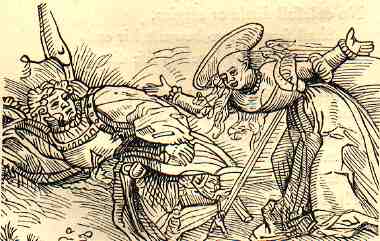Suicide on stage
Most of the suicides which appear in Shakespeare's plays don't conform to a single moral viewpoint or tradition. A tragic hero who unwaveringly follows the code of "death before dishonor" would show little of the inner conflict and self-doubt which make for compelling tragedy.
Shakespeare's plays demonstrate the versatility of suicide as a dramatic device. Since suicide was such a controversial -- and sometimes paradoxical -- subject (see the previous page), a particular character's suicide could provoke a wide range of emotions: from horror and condemnation to pity and even respect. The links below discuss various types of suicide in Shakespeare's drama.
Footnotes
-
The honorable thing?
On one level, Othello's suicide is that of a dignified soldier who, in typical Stoic fashion, sees death as the only escape from the miseries of life. Othello still maintains his nobility and is committed to act honorably by killing himself:
I have done the state some service, and they know't.
No more of that. I pray you, in your letters,
When you shall these unlucky deeds relate,
Speak of me as I am. Nothing extenuate,
Nor set aught down in malice.
(5.2.338)Othello's last words are similar to the final speech which, in Elizabethan custom, noble prisoners were expected to deliver to the audience before their execution. The purpose of this speech was to allow the prisoner to make a last appeal for his or her good name, although the audience certainly would have appreciated it more for the theatricality which it added to the execution. Sir Walter Raleigh was known for the moving (and lengthy) speech he made before his execution in 1618.
However, Shakespeare may also have been referring to the Christian connotations of shame and despair in the same speech (see the next note).
-
A betrayal?
Othello's final speech, just before he stabs himself, contains an interesting textual ambiguity. Most modern editions of the play follow the first quarto, in which Othello describes himself as "the base Indian, [who] threw a pearl away [Desdemona] / richer than all his tribe" (5.2.346-7). The Folio, however, has "base Judean," which suggests that Othello was comparing himself to Judas (the only apostle from the tribe of Judah) who, like Othello, killed himself in despair after a betrayal. In typical Shakspearean fashion, "Judean" may also be a double reference to Herod the Great, who killed his wife in a fit of jealousy.
If "Judean" is taken as the correct reading, then Shakespeare draws on two conflicting ways of thinking about suicide -- all within the same few lines.
-
Death before dishonor
A common type of suicidal character was a woman (often a virgin) who kills herself either to avoid rape or as a consequence of it. Shakespeare's narrative poem The Rape of Lucrece tells the story of the loyal and chaste Roman wife who is raped and kills herself out of shame. In his particularly bloody Roman play, Titus Andronicus, Shakespeare presents another rape victim named Lavinia whose tongue is cut out so that she cannot name her rapist. At the end of the play Lavinia is killed by her own father who cannot live with her dishonor.
Although Lavinia's death is not a suicide, both she and Lucrece exemplify the Roman value of family honor over life. Shakespeare depicts both victims with great sympathy. By writing about the issue of suicide and rape, Shakespeare was dealing with a moral problem which had long been controversial: was it right for a chaste woman to kill herself because of rape (or the threat of it)?
-
Lovers united in death
For tragic lovers like Romeo and Juliet who could not find happiness with each other in life, suicide was a way to be symbolically united in death. The sanctity of the tomb replaced that of the marriage bed, as Romeo's final speech suggests:
Shall I believe
That unsubstantial Death is amorous,
And that the lean abhorrèd monster keeps
Thee here in dark to be his paramour?
For fear of that, I still will stay with thee
And never from this pallet of dim night
Depart again
(5.3.102)By ending their lives while their love is in its prime, Romeo and Juliet transcend the corrupting influences of time and circumstance. Their love becomes idealized and untouchable, liberated from what Romeo calls "this world-wearied flesh". A similar pattern is evident in Cleopatra's suicide and those of Pyramus and Thisbe in the play-within-a-play staged in A Midsummer Night's Dream.
The connection between love and death was prominent in the literature of neoplatonic courtly love, especially the idea that death was the ultimate consummation of true love.
-
Getting rid of the villain
Suicide was a good way for dramatists to take care of female villains who had to be killed but could not die in combat or be executed. Two of Shakespeare's most notorious characters of this sort are Goneril [from King Lear] and Lady Macbeth. Both commit suicide when it appears that their respective plans have failed and their forces are about to lose. Both suicides also take place offstage and are reported to the audience by other characters.
